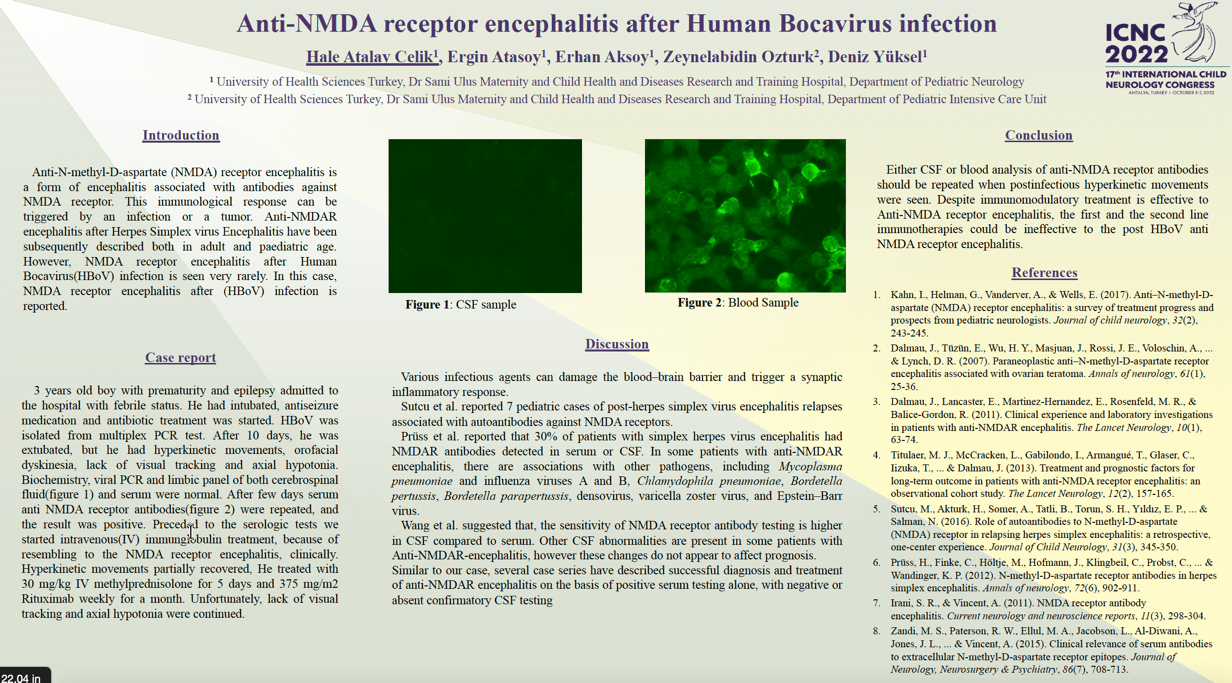Anti-NMDA receptor encephalitis after Human Bocavirus infection
Hale Atalay Celik, Ergin Atasoy, Bahadır Konuskan, Zeynelabidin Ozturk, Deniz Yuksel
Introduction: Anti-N-methyl-D-aspartate (NMDA) receptor encephalitis is a form of encephalitis associated with antibodies against NMDA receptor. This immunological response can be triggered by an infection or a tumor. Anti-NMDAR encephalitis after Herpes Simplex virus Encephalitis have been subsequently described both in adult and paediatric age. However, NMDA receptor encephalitis after Human Bocavirus(HBoV) infection is seen very rarely. Method: In this case, NMDA receptor encephalitis after (HBoV) infection is reported. Results:Case: 3 years old boy with prematurity and epilepsy admitted to the hospital with febrile status. He had intubated, antiseizure medication and antibiotic treatment was started. HBoV was isolated from multiplex PCR test. He was diagnosed as HBoV septicemia. After 10 days, he was exbubated,but he had hyperkinetic movements, orofacial dyskinesia, lack of visual tracking and axial hypotonia. Biochemistry, viral PCR and limbic panel of cerebrospinalfluid/serum were normal. After few days serum anti NMDA antibodies were repeated, and the result was positive. Preceded to the serologic tests we started intravenous(IV) immunglobulin treatment, because of resembling to the NMDA receptor encephalitis, clinically. Hyperkinetic movements partially recovered, He treated with 30 mg/kg IV methylprednisolon for 5 days and 375 mg/m2 Rituximab weekly for a month. Unfortunately, lack of visual tracking and axial hypotonia were continued. Conclusion: Either CSF or blood analysis of anti-NMDA antibodies should be repeated when postinfectious hyperkinetic movements were seen. Despite immunomodulatory treatment is effective to Anti-NMDA receptor encephalitis, to the first and second line immunotherapies could be ineffective to postHBoV anti NMDA receptor encephalitis.
Keywords: Anti-NMDA, encephalitis, Human Bocavirus, hyperkinetic movement
Hale Atalay Celik
University of Health Sciences Turkey, Dr Sami Ulus Maternity and Child Health and Diseases Research and Training Hospital
Turkey
Ergin Atasoy
University of Health Sciences Turkey, Dr Sami Ulus Maternity and Child Health and Diseases Research and Training Hospital
Turkey
Bahadır Konuskan
University of Health Sciences Turkey, Dr Sami Ulus Maternity and Child Health and Diseases Research and Training Hospital
Turkey
Zeynelabidin Ozturk
University of Health Sciences Turkey, Dr Sami Ulus Maternity and Child Health and Diseases Research and Training Hospital
Turkey
Deniz Yuksel
University of Health Sciences Turkey, Dr Sami Ulus Maternity and Child Health and Diseases Research and Training Hospital
Turkey
Introduction: Anti-N-methyl-D-aspartate (NMDA) receptor encephalitis is a form of encephalitis associated with antibodies against NMDA receptor. This immunological response can be triggered by an infection or a tumor. Anti-NMDAR encephalitis after Herpes Simplex virus Encephalitis have been subsequently described both in adult and paediatric age. However, NMDA receptor encephalitis after Human Bocavirus(HBoV) infection is seen very rarely. Method: In this case, NMDA receptor encephalitis after (HBoV) infection is reported. Results:Case: 3 years old boy with prematurity and epilepsy admitted to the hospital with febrile status. He had intubated, antiseizure medication and antibiotic treatment was started. HBoV was isolated from multiplex PCR test. He was diagnosed as HBoV septicemia. After 10 days, he was exbubated,but he had hyperkinetic movements, orofacial dyskinesia, lack of visual tracking and axial hypotonia. Biochemistry, viral PCR and limbic panel of cerebrospinalfluid/serum were normal. After few days serum anti NMDA antibodies were repeated, and the result was positive. Preceded to the serologic tests we started intravenous(IV) immunglobulin treatment, because of resembling to the NMDA receptor encephalitis, clinically. Hyperkinetic movements partially recovered, He treated with 30 mg/kg IV methylprednisolon for 5 days and 375 mg/m2 Rituximab weekly for a month. Unfortunately, lack of visual tracking and axial hypotonia were continued. Conclusion: Either CSF or blood analysis of anti-NMDA antibodies should be repeated when postinfectious hyperkinetic movements were seen. Despite immunomodulatory treatment is effective to Anti-NMDA receptor encephalitis, to the first and second line immunotherapies could be ineffective to postHBoV anti NMDA receptor encephalitis.
Keywords: Anti-NMDA, encephalitis, Human Bocavirus, hyperkinetic movement
Hale Atalay Celik
University of Health Sciences Turkey, Dr Sami Ulus Maternity and Child Health and Diseases Research and Training Hospital
Turkey
Ergin Atasoy
University of Health Sciences Turkey, Dr Sami Ulus Maternity and Child Health and Diseases Research and Training Hospital
Turkey
Bahadır Konuskan
University of Health Sciences Turkey, Dr Sami Ulus Maternity and Child Health and Diseases Research and Training Hospital
Turkey
Zeynelabidin Ozturk
University of Health Sciences Turkey, Dr Sami Ulus Maternity and Child Health and Diseases Research and Training Hospital
Turkey
Deniz Yuksel
University of Health Sciences Turkey, Dr Sami Ulus Maternity and Child Health and Diseases Research and Training Hospital
Turkey

Hale Atalay Celik
University of Health Sciences Turkey, Dr Sami Ulus Maternity and Child Health and Diseases Research and Training Hospital Turkey
University of Health Sciences Turkey, Dr Sami Ulus Maternity and Child Health and Diseases Research and Training Hospital Turkey